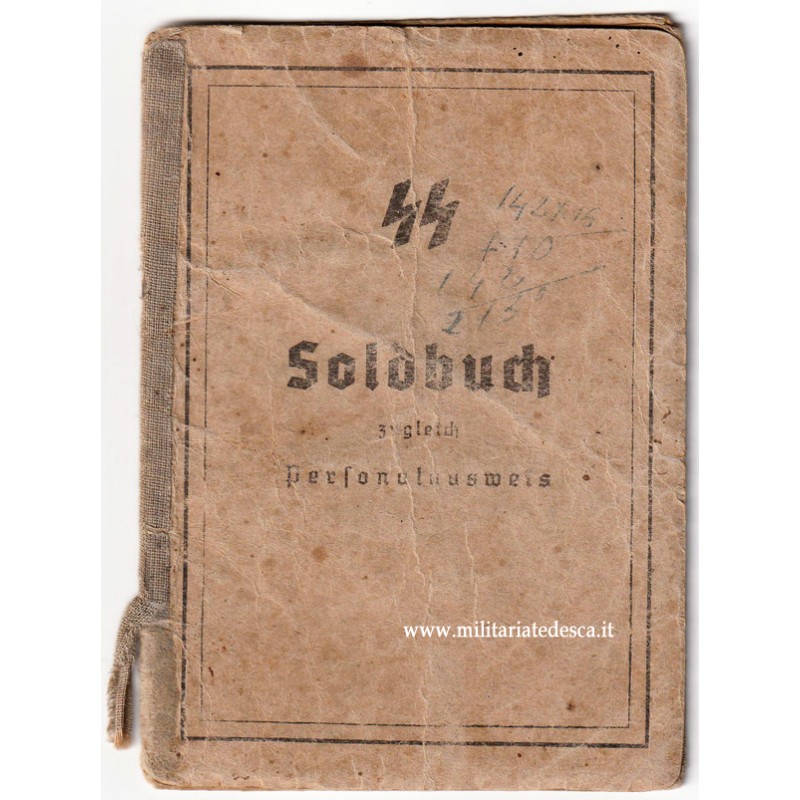- SOLD















Wonderful historical personal document, a Soldbuch, found in north Italy. This document was picked up from a family that got it in 1945. Interesting note: the central pages of the Soldbuch were used post war as notebook; some pencil writings the pencil notes describe some wood deliveries and the related payments. One page of equipment is missing.
This Soldbuch belonged to Edmund Sievert, a soldier who fought with the SS-Panzergrenadier Lehr Regiment and afterwards in 16 SS-Panzergrenadier Division "Reichsführer SS", in Italy and Hungary.
The original SS-Panzergrenadier Lehr Regiment was an elite, well trained demonstration unit. It was part of faculty of the SS-Panzergrenadierschule at Prosetschnitz/Kienschlag (which was itself part of the Beneschau Troop Training Grounds, in the countryside outside of Prague). At Kienschlag, the Lehr Reg. helped test new weapons, such as the Sturmgewehr, and develop tactics to meet the changing conditions of the war.
This first version of the Lehr Reg. was sent to Hungary in March 1944, and there its men were integrated into the forming 16. SS-Panzergrenadier Division "RFSS".
Subsequently, the division’s troops were stationed at Debrecen.
On 18 May 1944, the division was ordered to move back to Livorno, Italy. On 20 May, they moved by rail to Italy and the first elements of the division began arriving in Livorno on 26 May, where they came under command of 75. Armeekorps. The division moved into the front line between the Marina Carrara and Calafuria on 31 May. On 27 June the division’s command post in San Vincenzo was overrun by the US 1st Battalion, 133rd Infantry, 34th Infantry Division (Red Bulls).
On 3 August 1944, 16. SS-Panzergrenadierdivision ‘Reichsführer SS’ was pulled out of its defensive positions and moved to the area south of Bologna. Here, the division rested and finally received it full complement of heavy weapons. During this time the division was in anti-partisan duties. The division went about this task with much brutality and killed over 2,000 civilians, including one incident at Sant’Anna di Strazzema where 560 people were killed, including 116 children under 16 years and 8 pregnant women. Another brutal suppression at Marzabotto resulted in 770 civilian deaths. Schools, churches and monasteries were also destroyed in these operations.
In early September 1944, the division’s strength was 14,683 men and replaced 362. Infanteriedivision in positions north of Pistoia. By early December 1944, remained on this relatively quiet front. Attempts by the Allies to advance on Bologna were thwarted. On 20 December the division in to reserve in the area south of Lake Comacchino. The division replaced 98. Infanteriedivision in 73. Armeekorps behind the Senio River between Lugo and Fusigano, west of Ravenna, on 28 December 1944.
In January 1945, the division was moved to Hungary and assembled at Nagykanizsa. On 6 March 1945, Operation Frühlingserwachen (Spring Awakening), the German offensive at Lake Balaton, began.
16. SS-Panzergrenadierdivision ‘Reichsführer SS’ advanced from Nagybajoms to Kaposvar, where they struck the well-prepared and Soviet defences. After a 4 km advance, they were halted at Kisbajom. The division was then withdrawn from the front and moved to Marczali. On 14 March 1945 the division began another attack towards Nikla, but heavy Red Army fire turned them back and the division suffered heavy losses. By 24 March, the divisions had a total strength of 9,399 men, but its combat strength had to be reduced to 3,134 men. Three days later, the division received orders to move to Pacsa.
The Soviets began their own offensive on 29 March 1945. 16. SS-Panzergrenadierdivision ‘Reichsführer SS’ was split, with the bulk of the division moved back to the area of Nagy-Kanizsa. The continued to withdraw towards Austria. By 4 April 1945, the division had withdrawn to the area of Luttenberg and came under the command of 22. Armeekorps. Three days later the division was transferred to 1. Kavalleriekorps in Straden. At the training area of ‘Alt-Neudorf’ the division was reinforced with Luftwaffe and Kriegsmarine personnel, as well as Hungarian volunteers. The division was moved to the Radkersburg staging areas on 13 April 1945. They fought in the following days to the north and west of Straden and Poppendorf.
After the surrender of the German forces in Italy, the division was transferred to the 22. Gebirgskorps in the area of Marburg and Lavamünd.
On 9 May 1945 the division surrendered to British forces in the Klagenfurt area west of Graz, Austria.